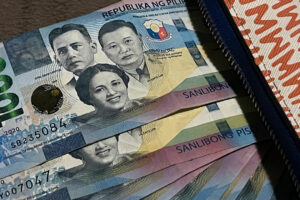




Philippines Trade Update: Trade trajectories trend along
 DOWNLOAD
DOWNLOAD

Policy Rate Updates: Double cut finale
 DOWNLOAD
DOWNLOAD

Monthly Economic Update: One for the road
 DOWNLOAD
DOWNLOAD


Peso seen to trade sideways ahead of rate-setting moves

The peso could trade sideways versus the dollar this week ahead of the rate-setting meetings by the US Federal Reserve and by the Bangko Sentral ng Pilipinas (BSP).
The local unit closed at PHP 56.815 versus the dollar on Friday, weakening by five centavos from Thursday’s PHP 56.765 finish, data from the Bankers Association of the Philippines’ website showed.
Week on week, the peso likewise fell by 18.50 centavos from its PHP 56.63 close on Sept. 8.
The local unit opened Friday’s session at PHP 56.78 per dollar, which was also its intraday best. Its weakest showing was at PhP 56.90 against the greenback.
Dollars traded rose to USD 1.06 billion on Friday from USD 1.17 billion on Thursday.
The peso weakened against the dollar on Friday “after mostly stronger US retail sales and US producer price index (PPI) data that could support the higher-for-longer Fed rates narrative,” Rizal Commercial Banking Corp. Chief Economist Michael L. Ricafort said in a Viber message.
“[The] US dollar strengthened against most currencies [on Friday] following resilient US economic data,” a trader added in a Viber message.
The dollar index surged to a six-month high on Thursday as economic data was mostly stronger than expected, hitting the 105.43 level earlier in the day, its highest since March 9.
The index was on track for its biggest one-day percentage gain in just over a week, Reuters reported.
Retail sales rose by 0.6% last month. Data for July was revised lower to show sales advancing 0.5% instead of the previously reported 0.7%. Economists polled by Reuters had forecast retail sales gaining 0.2%. Retail sales are mostly goods and are not adjusted for inflation. They rose 2.5% on a year-on-year basis.
Meanwhile, the producer price index (PPI) for final demand rose 0.7% last month, the largest gain since June 2022, the Labor department said on Thursday. Data for July was revised slightly to show the PPI advancing 0.4% instead of the previously reported 0.3%.
Higher global crude oil prices recently and losses at the local stock market also dragged down the peso, Mr. Ricafort added.
Brent crude futures rose by 23 cents or 0.3% to settle at USD 93.93 a barrel, while US West Texas Intermediate futures were up 61 cents or 0.7% to close at USD 90.77 a barrel. Both contracts traded at 10-month highs on Tuesday for the fifth consecutive session and gained about 4% on a weekly basis.
Meanwhile, the benchmark Philippine Stock Exchange index (PSEi) went down by 82.06 points or 1.32% to end at 6,126.34 on Friday, while the broader all shares index dipped by 33.13 points or 0.99% to close at 3,320.18.
The PSEi on Wednesday sank to the 6,100 level due to concerns about US inflation. This was its lowest level in 10 months or since October 2022.
For this week, Mr. Ricafort said the peso could trade sideways ahead of the rate-setting meetings by central banks.
The Fed raised interest rates by 25 basis points (bps) last month, bringing its benchmark overnight rate to a range between 5.25% and 5.5%.
It has hiked rates by a cumulative 525 bps since it began its tightening cycle in March last year.
The Federal Open Market Committee will next meet on Sept. 19-20 to review policy.
Meanwhile, the BSP extended its policy pause for a third straight time at its Aug. 17 meeting, keeping the benchmark interest rate at a near 16-year high of 6.25%.
The central bank has raised borrowing costs by 425 bps from May 2022 to March 2023 to tame inflation.
The Monetary Board will next meet on Sept. 21 to review policy.
The trader said the peso is likely to remain below the PHP 57-per-dollar level due to a potential intervention from the BSP.
The trader sees the peso moving between PHP 56.50 and PHP 57 per dollar this week, while Mr. Ricafort sees it ranging from PHP 56.50 to PHP 56.95. — Aaron Michael C. Sy with Reuters
This article originally appeared on bworldonline.com





 By BusinessWorld
By BusinessWorld